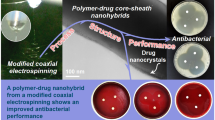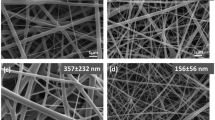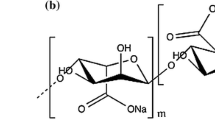Abstract
Synthetic ampicillin (AM)/starch (ST)/polymer composite nanofibers were fabricated during the electrospinning process, and it was found that the nanofibers had efficient and controlled drug release properties. AM, an antibacterial drug, was successfully encapsulated inside the ST-based composite nanofibers. The addition of biocompatible polymers, polyvinyl alcohol and polyethylene oxide, could efficiently improve the electrospinnability of ST aqueous solutions. The results of the density functional theory (DFT) calculation indicate that hydrogen bond interactions exist between AM and ST. Through the in vitro drug release studies, it was found that the AM release properties of the ST-based composite nanofibers could be controlled through manipulating drug loading, the ratio of ST to polymers, the species of polymers, and the weight of tablet.
Graphical Abstract
Synthetic ampicillin/starch/polymer composite nanofibers were fabricated during the electrospinning process, and it was found that the nanofibers had efficient and controlled drug release properties. The release of ampicillin from the starch-based composite nanofibers could be efficiently controlled through manipulating the ratio of starch to polymers, drug loading, species of polymers, and weight of tablets. Additionally, DFT calculation was used to investigate the interaction between ampicillin and starch.









Similar content being viewed by others
References
Grover M, Utreja P (2014) Recent advances in drug delivery systems for anti-diabetic drugs: a review. Curr Drug Deliv 11(4):444–457
Vashist A, Vashist A, Gupta YK, Ahmad S (2014) Recent advances in hydrogel based drug delivery systems for the human body. J Mater Chem B 2(2):147–166
Malik R, Garg T, Goyal AK, Rath G (2015) Polymeric nanofibers: targeted gastro-retentive drug delivery systems. J Drug Target 23(2):109–124
Pelipenko J, Kocbek P, Kristl J (2015) Critical attributes of nanofibers: preparation, drug loading, and tissue regeneration. Int J Pharm 484(1–2):57–74
Hu X, Liu S, Zhou G, Huang Y, Xie Z, Jing X (2014) Electrospinning of polymeric nanofibers for drug delivery applications. J Control Release 185:12–21
Zhang C-L, Yu S-H (2014) Nanoparticles meet electrospinning: recent advances and future prospects. Chem Soc Rev 43(13):4423–4448
Ahmed FE, Lalia BS, Hashaikeh R (2015) A review on electrospinning for membrane fabrication: challenges and applications. Desalination 356:15–30
Huang ZM, Zhang YZ, Kotaki M, Ramakrishna S (2003) A review on polymer nanofibers by electrospinning and their applications in nanocomposites. Compos Sci Technol 63(15):2223–2253
Oliveira MF, Suarez D, Rocha JCB, Teixeira AVND, Cortes ME, De Sousa FB, Sinisterra RD (2015) Electrospun nanofibers of polyCD/PMAA polymers and their potential application as drug delivery system. Mater Sci Eng C-Mater 54:252–261
Lu TC, Chen XS, Shi Q, Wang Y, Zhang PB, Jing XB (2008) The immobilization of proteins on biodegradable fibers via biotin-streptavidin bridges. Acta Biomater 4(6):1770–1777
Shi Q, Chen XS, Lu TC, Jing XB (2008) The immobilization of proteins on biodegradable polymer fibers via click chemistry. Biomaterials 29(8):1118–1126
Yoo HS, Kim TG, Park TG (2009) Surface-functionalized electrospun nanofibers for tissue engineering and drug delivery. Adv Drug Deliver Rev 61(12):1033–1042
Schiffman JD, Schauer CL (2008) A review: electrospinning of biopolymer nanofibers and their applications. Polym Rev 48(2):317–352
Wang Y, Yang J, Chen L (2015) Convenient fabrication of electrospun prolamin protein delivery system with three-dimensional shapeability and resistance to fouling. ACS Appl Mater Interfaces 7(24):13422–13430
Okuda T, Tahara Y, Kamiya N, Goto M, Kidoaki S (2013) S/O-nanodispersion electrospun fiber mesh effective for sustained release of healthy plasmid DNA with the structural and functional integrity. J Biomater Sci-Polym E 24(10):1277–1290
Islam MS, Rahaman MS, Yeum JH (2015) Electrospun novel super-absorbent based on polysaccharide-polyvinyl alcohol-montmorillonite clay nanocomposites. Carbohydr Polym 115:69–77
Huang J, Zhao LX, Man JM, Wang J, Zhou WD, Huai HY, Wei CX (2015) Comparison of physicochemical properties of B-type nontraditional STs from different sources. Int J Biol Macromol 78:165–172
Paleos CM, Sideratou Z, Theodossiou TA, Tsiourvas D (2015) Carboxylated hydroxyethyl starch: a novel polysaccharide for the delivery of doxorubicin. Chem Biol Drug Des 85(5):653–658
Narayanan D, Nair S, Menon D (2015) A systematic evaluation of hydroxyethyl starch as a potential nanocarrier for parenteral drug delivery. Int J Biol Macromol 74:575–584
Kong LY, Ziegler GR (2012) Role of molecular entanglements in starch fiber formation by electrospinning. Biomacromolecules 13(8):2247–2253
Kong LY, Ziegler GR (2014) Fabrication of pure starch fibers by electrospinning. Food Hydrocolloid 36:20–25
Tapisiz A, Ozdemir H, Ciftci E, Belet N, Ince E, Dogru U (2011) Ampicillin/sulbactam for children hospitalized with community-acquired pneumonia. J Infect Chemother 17(4):504–509
Baraldi C, Tinti A, Ottani S, Gamberini MC (2014) Characterization of polymorphic ampicillin forms. J Pharm Biomed 100:329–340
Yang H, Gao PF, Wu WB, Yang XX, Zeng QL, Li C, Huang CZ (2014) Antibacterials loaded electrospun composite nanofibers: release profile and sustained antibacterial efficacy. Polym Chem 5(6):1965–1975
Sohrabi A, Shaibani PM, Etayash H, Kaur K, Thundat T (2013) Sustained drug release and antibacterial activity of ampicillin incorporated poly(methyl methacrylate)–nylon6 core/shell nanofibers. Polymer 54(11):2699–2705
Sabitha M, Rajiv S (2015) Preparation and characterization of ampicillin-incorporated electrospun polyurethane scaffolds for wound healing and infection control. Polym Eng Sci 55(3):541–548
Liu H, Leonas KK (2010) Weight loss and morphology changes of electrospun poly(ɛ-caprolactone) yarns during in vitro degradation. Fibers Polym 11(7):1024–1031
Frisch MJ, Trucks GW, Schlegel HB, Scuseria GE, Robb MA, Cheeseman JR, Scalmani G, Barone V, Mennucci B, Petersson GA, Nakatsuji H, Caricato M, Li X, Hratchian HP, Izmaylov AF, Bloino J, Zheng G, Sonnenberg JL, Hada M, Ehara M, Toyota K, Fukuda R, Hasegawa J, Ishida M, Nakajima T, Honda Y, Kitao O, Nakai H, Vreven T, Montgomery JA Jr, Peralta JE, Ogliaro F, Bearpark M, Heyd JJ, Brothers E, Kudin KN, Staroverov VN, Kobayashi R, Normand J, Raghavachari K, Rendell A, Burant JC, Iyengar SS, Tomasi J, Cossi M, Rega N, Millam JM, Klene M, Knox JE, Cross JB, Bakken V, Adamo C, Jaramillo J, Gomperts R, Stratmann RE, Yazyev O, Austin AJ, Cammi R, Pomelli C, Ochterski JW, Martin RL, Morokuma K, Zakrzewski VG, Voth GA, Salvador P, Dannenberg JJ, Dapprich S, Daniels AD, Farkas O, Foresman JB, Ortiz JV, Cioslowski J, Fox DJ (2009) Gaussian 09, revision A.02. Gaussian Inc, Wallingford
Han XZ, Chen S, Hu XG (2009) Controlled-release fertilizer encapsulated by starch/polyvinyl alcohol coating. Desalination 240(1–3):21–26
Wojcik AB, Ting A, Klein LC (1998) High molecular weight poly(ethylene oxide)/silica hybrids by the sol-gel process. Mater Sci Eng C 6(2–3):115–120
Jayasekara R, Harding I, Bowater I, Christie GBY, Lonergan GT (2004) Preparation, surface modification and characterisation of solution cast starch PVA blended films. Polym Test 23(1):17–27
Joshi SS, Mebel AM (2007) Computational modeling of biodegradable blends of starch amylose and poly-propylene carbonate. Polymer 48(13):3893–3901
Acknowledgments
We gratefully acknowledge Financial Support by the NSFC (Nos. 21302062, 21301048, and 21563002) and The Science and Technology Developmental Plan of Jilin Province (No. 20120303045ZY). The Hebei Province Natural Science Fund (Nos. B2013209247 and B2013209248) and Tangshan Basic Research Development Program (131302104b and 131302105b) are also acknowledged.
Author information
Authors and Affiliations
Corresponding author
Ethics declarations
Conflict of interest
None.
Research involving human participants and/or animals
Our research does not involve Human Participants and/or Animals experiments.
Informed consent
All the authors agreed to publish the manuscript in “Journal of Sol-Gel Science and Technology.”
Electronic supplementary material
Below is the link to the electronic supplementary material.
Rights and permissions
About this article
Cite this article
Tang, S., Zhao, Z., Chen, G. et al. Fabrication of ampicillin/starch/polymer composite nanofibers with controlled drug release properties by electrospinning. J Sol-Gel Sci Technol 77, 594–603 (2016). https://doi.org/10.1007/s10971-015-3887-x
Received:
Accepted:
Published:
Issue Date:
DOI: https://doi.org/10.1007/s10971-015-3887-x




